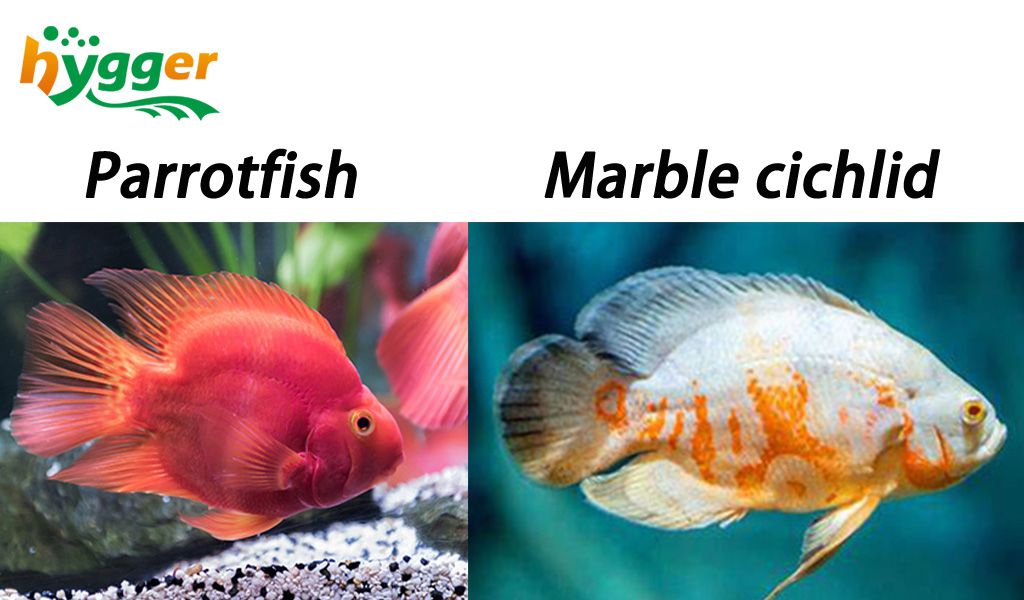10 Best Midwater Fish For Freshwater Aquarium
Generally, there are different kinds of dwellers in aquariums – bottom, middle, and top dwellers. They make diverse vibrant fish tanks. Specifically in this article, we will get deep into the midwater fish for freshwater aquariums. If you have ever been on the horns of a dilemma when selecting middle dwellers for your aquarium, just continue reading.
Content Table
Midwater fish – what freshwater fish stay in the middle of the tank
Midwater fish refer to those fish that fancy living and swimming in the middle of an aquarium. Nonetheless, sometimes they may live or swim at the top or the bottom. Next, we will list some midwater fish:
- Most tetras (like: Neon tetra, Congo tetra, Serpae tetra/Von rio tetra)
- Rosy barbs
- Tiger barbs
- Cherry barb
- Rainbowfish
- Harlequin and Lambchop rasboras
- Angelfish
- Gouramis (e.g. Blue gouramis)
- Koi fish
- Goldfish
- Parrotfish
- Marble cichlid/Oscar
What are the characteristics of midwater fish
In this part, we will talk about the characteristics of midwater fish. Parrotfish and marble cichlids, for instance.
Parrotfish
Parrotfish are omnivores and need huge meals. It is feasible to feed red worms, daphnia, earthworms, small fish, and pellets. And food with rich astacin will make the fish color brighter. Nevertheless, small river fish should be avoided. Otherwise, the parrotfish would begin fading. In addition to this, parrotfish also possess great adaptability to water temperature. But low water temperature and water temperature fluctuation would lead to color fading, and they may even get sick or face death.
Marble cichlids
Marble cichlids are not clumsy, actually, they are flexible swimmers and swift hunters. The cichlids are carnivorous, and greedy in eating. You can feed them earthworms, small fish and shrimp, or other food. On the other hand, marble cichlids are aggressive, and they may eat other small fish. Thus, you should be cautious when choosing tank mates for them. It is not advisable to keep marble cichlids with other small fish.
In short, each fish species have its highlights. The parrotfish are peaceful, while the marble cichlids are aggressive. Besides, there are other peaceful midwater fish, like tetras, rainbow shiners, and rainbowfish, which are also fit for community tanks. Furthermore, midwater fish can eat the sinking food, but also seek meals at the bottom of the fish tank.
Best middle-dwelling fish listing
Until now, you must have a basic understanding of midwater fish. Next in this segment, we will discuss the ten best middle-dwelling fish.
1. Neon Tetras
With a silver-white abdomen, light-blue back, and transparent fins and tails, neon tetras also have a blue horizontal strip from the nose to the base of the adipose fin, as well as a red strip extending from the middle of the body to the base of the caudal fin. For more additional information about neon tetra maintenance, you can go to How do You Care for a Neon Tetra Fish Tank.
| Family | Characidae | 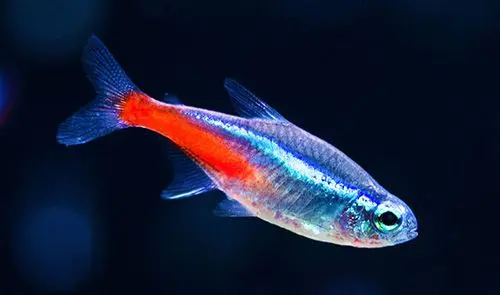 |
|
| Water temperature | 75-80℉ | ||
| pH level | 6.8-7.8 | ||
| Size | 1.5-2 inches | ||
| Lifespan | 5-8 years | ||
| Diet | Omnivores | ||
| Temperament | Peaceful | Minimum tank size |
10-20 gallon |
2. Tiger Barbs
Tiger barbs have a triangular-shaped snout, a pointed head, a high back, and a wide and round body. Besides, there are four vertical black strips on their body. Furthermore, their fins are red or orange. Additionally, tiger barbs are friendly for beginners as they are easy to care for. Curious about them? Just read Fish Profiles – How to Keep Tiger Barb Fish to know more.
| Family | Cyprinidae | 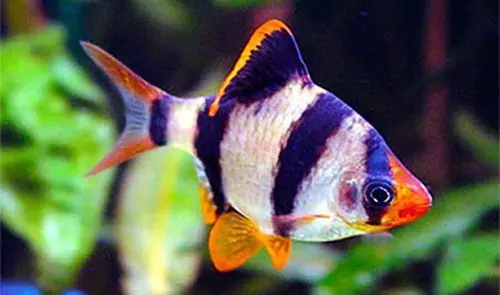 |
|
| Water temperature | 75-80℉ | ||
| pH level | 6.0-8.0 | ||
| Size | 2-3 inches | ||
| Lifespan | 5-7 years | ||
| Diet | Omnivores | ||
| Temperament | Semi-aggressive | Minimum tank size |
20 gallon |
3. Angelfish
Exactly, angelfish are classified into freshwater and saltwater. Featuring long fins, freshwater angelfish have a triangular snout and a wide body. And there are vertical black strips on the body. Furthermore, female ones are smaller and rounder than male angelfish. If you keep the angelfish in the reef tanks, you should know the Angelfish coral compatibility first.
| Family | Cichlidae | 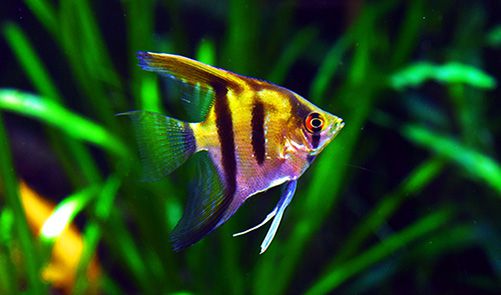 |
|
| Water temperature | 75-84℉ | ||
| pH level | 6.8-7.8 | ||
| Size | 5-8 inches | ||
| Lifespan | 10-12 years | ||
| Diet | Omnivores | ||
| Temperament | semi-aggressive | Minimum tank size |
20 gallon |
4. Blue Gouramis
Blue gouramis are labyrinth fish, which means that they can take in oxygen directly. And they have long and flat bodies. Usually, there are also spots on the body. Also, the spots fading may be a signal of metabolic stress for the reasons of overstocking or poor water quality.
| Family | Osphronemidae | 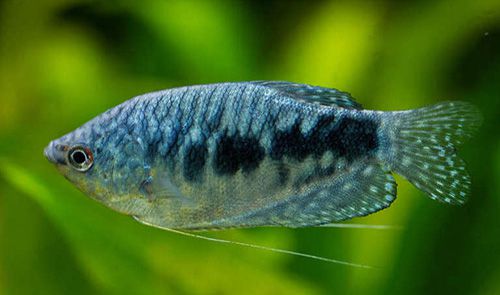 |
|
| Water temperature | 72-82℉ | ||
| pH level | 6.8-7.8 | ||
| Size | 5-6 inches | ||
| Lifespan | 3-5 years | ||
| Diet | Omnivorous | ||
| Temperament | Peaceful | Minimum tank size |
15-20 gallon |
5.Harlequin and Lambchop Rasboras
With a triangle black patch and an orange body, Harlequin and lambchop rasboras are fond of shallow water with plenty of aquatic plants. Besides that, the rasboras are hardy and have great adaptability. Hence, they are an excellent alternative for beginners.
| Family | Cyprinidae | 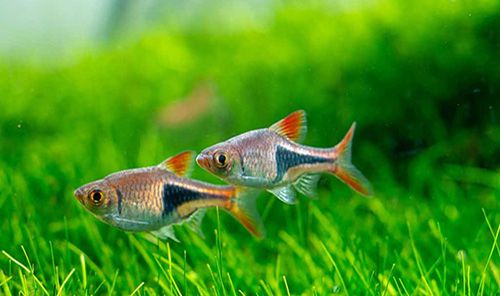 |
|
| Water temperature | 75-80℉ | ||
| pH level | 6.8-7.8 | ||
| Size | 1-2 inches | ||
| Lifespan | 5-8 years | ||
| Diet | Omnivorous | ||
| Temperament | Peaceful | Minimum tank size |
10 gallon |
6. Glass Catfish
Glass catfish are ideal for sophisticated aquarists. The transparent body makes you see the internal organs. Additionally, they are schooling fish. Consequently, you’d better keep them in a school of four or more.
| Family | Siluridae | 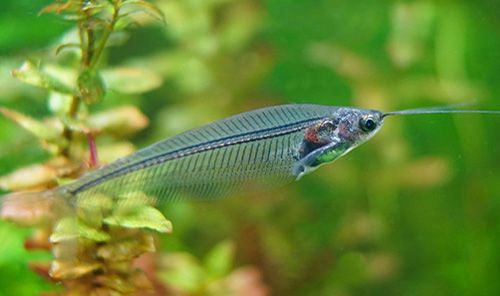 |
|
| Water temperature | 72-80℉ | ||
| pH level | 6.6-7.5 | ||
| Size | 2.5-3 inches | ||
| Lifespan | 7-8 years | ||
| Diet | Carnivores | ||
| Temperament | Peaceful | Minimum tank size |
30 gallon |
7. Rainbowfish
Rainbowfish possess two dorsal fins and compressed bodies. Also, they are colorful and bright. In addition to this, rainbowfish can be kept with other tropical fish, like guppies and tetras. And they can get along well with peaceful fish and fish of similar size. In winter, rainbowfish require an aquarium heater to maintain the tank water temperature between 74-80℉.
| Family | Melanotaeniidae | 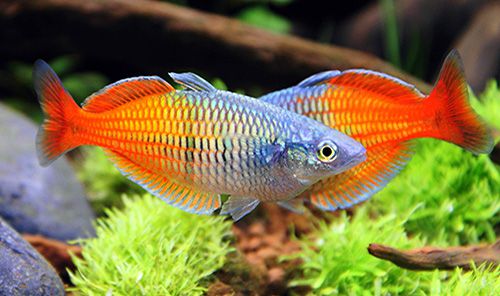 |
|
| Water temperature | 74-80℉ | ||
| pH level | 7.0-8.0 | ||
| Size | 3-7 inches | ||
| Lifespan | 5-8 years | ||
| Diet | Omnivores | ||
| Temperament | Peaceful | Minimum tank size |
15-30 gallon |
8. Pygmy Corydoras
Pygmy corydoras, also named pygmy catfish, have a silver body and two black lines on the body. Specifically, the former horizontal black line starts from the snout to the caudal part, and the line is on the center of both body sides. On the other side, the latter black line is thinner than the former, extending from the ventral fins to the tail.
| Family | Callichthyidae | 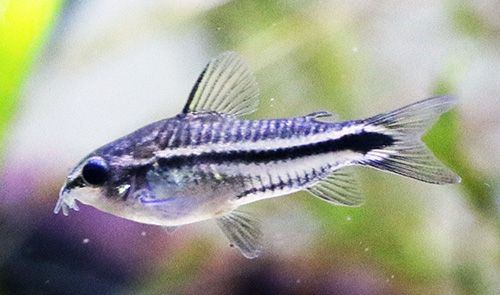 |
|
| Water temperature | 72-79℉ | ||
| pH level | 6.0-8.0 | ||
| Size | 0.75-1.3 inches | ||
| Lifespan | 3-5 years | ||
| Diet | Omnivores | ||
| Temperament | Peaceful | Minimum tank size |
10 gallon |
9. Celestial pearl danios
Featuring bright red or orange fins, and bodies with gold spots, celestial pearl danios are famous as the galaxy rasboras. Also, there are two black lines on their fins. In addition to this, celestial pearl danios are active and prefer slow-flowing or still water, and hiding places.
| Family | Cyprinidae | 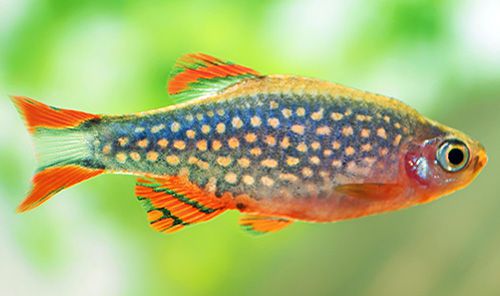 |
|
| Water temperature | 72-78℉ | ||
| pH level | 6.5-8.4 | ||
| Size | 0.75-1 inch | ||
| Lifespan | 3-5 years | ||
| Diet | Omnivores | ||
| Temperament | Peaceful | Minimum tank size |
10 gallon |
10. Rainbow shiners
Rainbow shiners are translucent, with pink and gold bodies. Moreover, there is a horizontal silver-black band on the body. Usually, rainbow shiners would breed during May and June. However, an interesting fact here. While mating, male ones will change their color. Specifically, their nose, head, and ventral fins will respectively turn red, purple, and blue.
| Family | Cyprinidae | 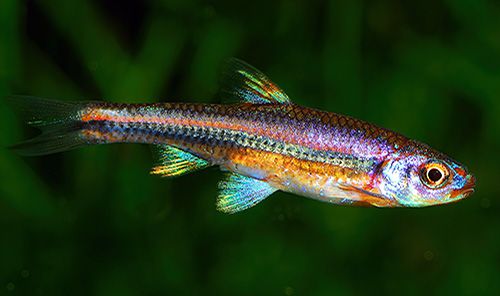 |
|
| Water temperature | 50-72℉ | ||
| pH level | 6.5-8.0 | ||
| Size | 2-3 inches | ||
| Lifespan | 1-3 years | ||
| Diet | Carnivores | ||
| Temperament | Peaceful | Minimum tank size |
15 gallon |
Sum up
After knowing more about midwater fish, do you want to have a try? If you want to build a nano aquarium in your office, neon tetras, pygmy corydoras, and celestial pearl danios are ideal options. That is all for today. For more other ideas, welcome to share in the comment. Finally, thanks for your reading.

